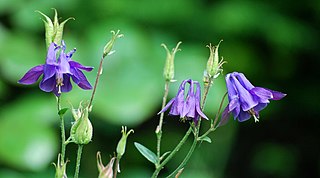
Aquilegia is a genus of about 60–70 species of perennial plants that are found in meadows, woodlands, and at higher altitudes throughout the Northern Hemisphere, known for the spurred petals of their flowers.

Aquilegia formosa, the crimson columbine, western columbine, or (ambiguously) "red columbine", is a common wildflower native to western North America, from Alaska to Baja California, and eastward to Montana and Wyoming.

Aquilegia canadensis, the Canadian or Canada columbine, eastern red columbine, or wild columbine, is a species of flowering plant in the buttercup family Ranunculaceae. It is an herbaceous perennial native to woodland and rocky slopes in eastern North America, prized for its red and yellow flowers. It readily hybridizes with other species in the genus Aquilegia.

Aquilegia coerulea, the Colorado blue columbine, is a species of flowering plant in the buttercup family Ranunculaceae, native to the Rocky Mountains, USA. Aquilegia coerulea is the state flower of Colorado.
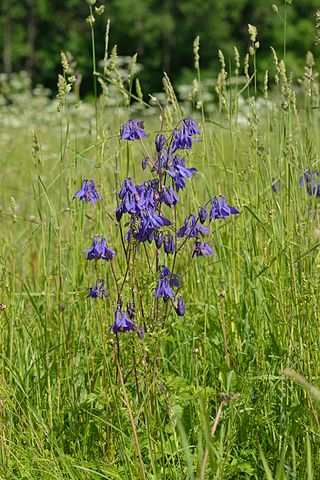
Aquilegia vulgaris is a species of columbine native to Europe with common names that include: European columbine, common columbine, granny's nightcap, and granny's bonnet. It is a flowering herbaceous perennial plant growing to 1.2 m tall, with branched, thinly hairy stems. The leaves are biternate; each leaf has three groups of three leaflets. The flowers, in various shades of purple, blue, pink and white, are pendent or horizontal with strongly hooked spurs, and appear in early summer.
1063 Aquilegia, provisional designation 1925 XA, is a background asteroid from the inner regions of the asteroid belt, approximately 17 kilometers in diameter. It was discovered on 6 December 1925, by German astronomer Karl Reinmuth at the Heidelberg Observatory in southwest Germany. The asteroid was named after the flowering plant Aquilegia (columbine).

Aquilegia barbaricina is a species of plant in the family Ranunculaceae. It is endemic to Italy, occurring only on the island of Sardinia.
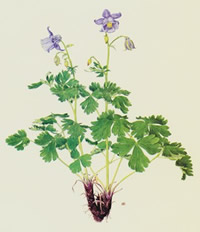
Aquilegia nuragica, commonly called Nuragica columbine, is a perennial species of plant in the family Ranunculaceae. It is endemic to Italy, on the island of Sardinia.

Aquilegia chrysantha, the golden columbine, is a perennial herbaceous plant native to the southwestern United States from extreme southern Utah to Texas and northwestern Mexico.

Aquilegia saximontana, the Rocky Mountain columbine, alpine dwarf columbine, dwarf blue columbine, or alpine columbine, is a perennial plant that comes from the buttercup family, Ranunculaceae.
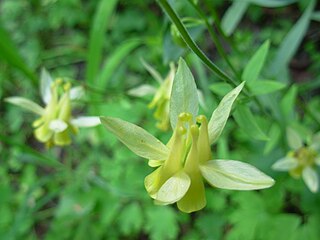
Aquilegia flavescens, the yellow columbine, is a wildflower native to mountain meadows, open woods, and alpine slopes of the Rocky Mountains from Utah north to British Columbia and Alberta.
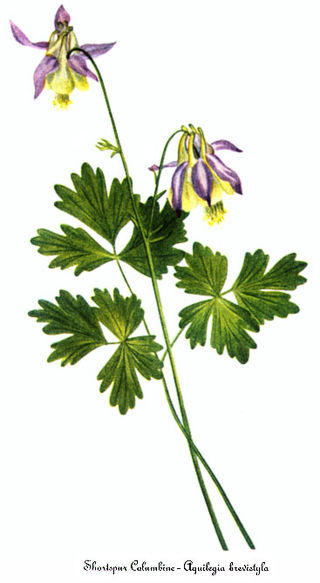
Aquilegia brevistyla is a species of flowering plant in the buttercup family known by the common name smallflower columbine. It is native to northern North America, where it has a disjunct distribution. Most of its range extends from Alaska through much of Canada, and it also occurs in a few areas in the contiguous United States, such as the Black Hills of South Dakota and central Montana. It is most common in eastern Alaska, Yukon, the southern Northwest Territories, and northern parts of Alberta, Manitoba, and Saskatchewan.

Aquilegia laramiensis is a species of flowering plant in the buttercup family known by the common name Laramie columbine. It is endemic to Wyoming in the United States, where it is known only from the Laramie Mountains.

Aquilegia flabellata, common name fan columbine or dwarf columbine, is a species of flowering perennial plant in the genus Aquilegia (columbine), of the family Ranunculaceae.

Aquilegia pyrenaica, common name Pyrenean columbine, is a species of flowering plant in the family Ranunculaceae. It is endemic to the Pyrenees where it grows on grassland and in rocky places. It was first described in 1805 by Augustin Pyramus de Candolle who gave it the name Aquilegia pyrenaica.

Aquilegia longissima, the long-spur columbine, is a rare perennial herb that is native to northern Mexico, Trans-Pecos Texas and southern Arizona. In the original species description by Asa Gray in 1883, Aquilegia longissima is distinguished from the shorter-spurred golden columbine Aquilegia chrysantha based on the extremely long spur over 10 cm long, narrow spatulate petals and very slender spurs that usually hang straight down. The petal spurs have been known to reach 16 cm in length, the longest nectary spurs of any Eudicot. The plants typically flower in the fall after monsoon rains and are found in oak-pine-juniper woodlands in shaded canyons near intermittent streams or on talus slopes.

A nectar spur is a hollow extension of a part of a flower. The spur may arise from various parts of the flower: the sepals, petals, or hypanthium, and often contain tissues that secrete nectar (nectaries). Nectar spurs are present in many clades across the angiosperms, and are often cited as an example of convergent evolution.

Aquilegia viridiflora, commonly known as the green columbine or green-flowered columbine, is a species of flowering plant in the buttercup family. Its native range is southern Siberia to northern China, and Japan. It is an herbaceous perennial, and grows 15 cm to 50 cm tall, with a maximum spread of approximately 30 cm. Although it is grown as an ornamental, it may be considered a weed.

Aquilegia ottonis is a species of flowering plant in the buttercup family. It has a broad distribution in Europe; it is native to Greece, Italy, and Albania. Plants produce blue-purple flowers which, based on pollination syndromes, are thought to be pollinated by bumblebees. A. ottonis is named after King Otto of Greece; the specific epithet 'ottonis' is the third declension of 'otto'.

Aquilegia barnebyi, commonly known as the oil shale columbine or Barneby's columbine, is a perennial species of flowering plant in the buttercup family, with a native range comprising northeastern Utah and northwestern Colorado in the United States. It is named after Rupert Charles Barneby, who, with Harry Dwight Dillon Ripley, first discovered it in Colorado.



















